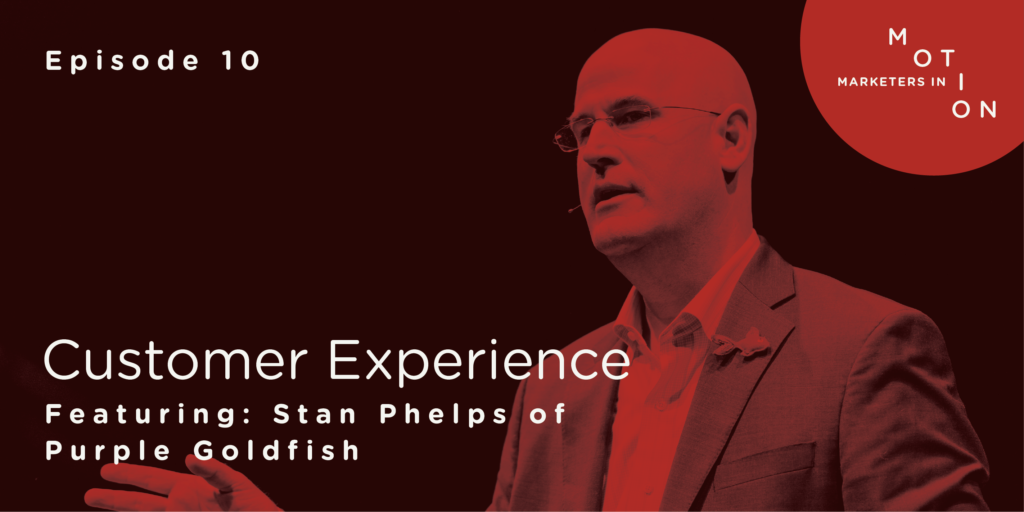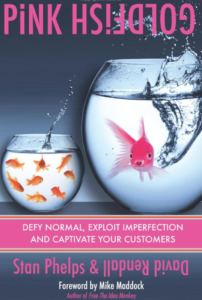
Customer Experience
July 16th, 2019
by Josh Janowiak
Customer Experience
Why is differentiation important? Why should companies care?
It’s easy to follow the crowd. It’s easy to blend in. It seems smart to do what other brands are doing. It feels safe. But it’s not. Successful brands stick out. They are different. They are unusual.
Be proud of what your brand does and what it doesn’t do. Be proud of your brand’s strengths and weaknesses. Don’t apologize for your flaws and don’t try to fix them. Instead, exploit your brand’s imperfections.
Key Topics
- Customer Experience
- Embracing your Uniqueness
- Differientiation
- Flaunting your Flaws
- Being Weird (Micro-weirding)
- Being Flawsome
Stan Phelps
Stan Phelps is a best-selling author, keynote speaker, and workshop facilitator. He believes that today’s organizations must focus on meaningful differentiation to win the hearts of both employees and customers.
He is the founder of PurpleGoldfish.com – a think tank of customer experience and employee engagement experts that offers keynotes and workshops that drive loyalty and sales. They help organizations connect with the hearts and minds of customers and employees.
Stan is a TEDx speaker, a Forbes contributor, and IBM Futurist. His writing is syndicated on top sites such as Customer Think and Business2Community. He has spoken at over 300 events in Australia, Bahrain, Canada, Ecuador, France, Germany, Holland, Israel, Japan, Malaysia, Peru, Sweden, Russia, Spain, UK, and the U.S.
He is the author of seven other books:
- Purple Goldfish – 12 Ways to Win Customers and Influence Word of Mouth
- Green Goldfish – 15 Ways to Drive Employee Engagement and Reinforce Culture
- Golden Goldfish – The Vital Few
- Blue Goldfish – Using Technology, Data, and Analytics to Drive Both Profits & Prophets
- Purple Goldfish – Service Edition – 12 Ways Hotels, Restaurants & Airlines Win the Right Customers
- Red Goldfish – Motivating Sales and Loyalty Through Shared Passion and Purpose
- Bar Tricks, Bad Jokes, and Even Worse Stories
Prior to PurpleGoldfish.com, Stan had a 20-year career in marketing that included leadership positions at IMG, adidas, PGA Exhibitions, and Synergy. At Synergy, he worked on award winning experiential programs for top brands such as KFC, Wachovia, NASCAR, Starbucks, and M&M’s.
Stan Phelps challenges leaders to think differently about their most important stakeholders: customers and employees. He inspires brands to be remark-able, showing them how to stand out in ways that customers and employees can’t help but talk about. His informative keynotes and workshops focus on the value of customer experience as a competitive differentiator, the role of employee engagement in building a strong corporate culture, and the impact of technology and purpose in business.
Stan Phelps
StanPhelpsSpeaks.com
PurlpleGoldfish.com
Pink Goldfish
Pink Goldfish
Not your ordinary business book. It aims to change the paradigm of how we fundamentally go about positioning our products / services and think about customer experience. Companies need to stand out in a crowded marketplace, but true differentiation is increasingly rare. Based on over 200 case studies, Pink Goldfish provides an unconventional seven-part framework for achieving competitive separation by embracing flaws, instead of fixing them. This executive summary outlines the Top Five takeaways from the book and the F.L.A.W.S.O.M. framework.
Being Weird
Why is differentiation important? Why should companies care?
Pink Goldfish is based on this concept that “weird is good”. Why is that?
Being weird makes you rare…being normal makes you ordinary.
- Scarcity increases value. Diamonds are valuable primarily because they are rare. Sand and salt are far less valuable, not because they aren’t useful, but because they are so ordinary and plentiful.
Being weird makes you original…being normal makes you easy to imitate.
- Keith Ferrazzi, in his book Never Eat Alone, argues that we must “be distinct or be extinct…. The best brands, like the most interesting people, have a distinct message…. When it comes to making an impression, differentiation is the name of the game. Confound expectation. Shake it up.” The value of any product or service immediately decreases once there are acceptable alternatives. An obvious example comes from the world of work. When someone’s job can be done faster or cheaper by a computer or an outsourced contractor in another location, that job becomes less valuable. The salary for that position decreases and the likelihood of being replaced increases. Original brands avoid imitation. They make it difficult to be replaced. There are no good substitutes.
Being weird makes you noticeable…being normal makes you invisible.
- Fitting in and following the herd makes us invisible. If we do things well, no one can see us. If our business fits in, everyone drives right by. No one stops. They don’t know we’re even there. If they do stop, they don’t stay long, and they don’t buy anything because our products or services are just like everyone else’s. If we fit in, we don’t get any attention. And attention is one of the most valuable gifts we can get from customers.
Being weird makes you surprising…being normal makes you predictable.
- As Chip and Dan Heath explain in Made to Stick, we are more likely to be persuaded by messages that are unexpected. If we can surprise someone, we create an emotional response. Our brain is programmed to release dopamine as part of an emotional response. Dopamine is literally the Post-it note for our memory. Surprising and ultimately delighting a customer generates experiences that are remembered and shared with others.
Being weird makes you memorable…being normal makes you forgettable.
- We remember the unusual events in our lives, not the common ones. If no one remembers your brand message, then you don’t have the opportunity to influence them. The worst criticism that Simon Cowell, the caustic judge of American Idol, can give is that a contestant is forgettable. In contrast, one of his most powerful compliments is that a contestant is memorable. He recently told one female singer, “You are such a strange person. I mean that as a compliment.” We remember people and businesses that are strange.
Being weird makes you influential…being normal makes you powerless.
- If other people are sharing your message, it increases your influence because it enables your message to reach a larger audience. A lot of people pay lip service to the value of being different and standing out. Many believe it’s an essential part of any marketing strategy. However, it is difficult to be different. When you try to be different, there will be pressure to fit in. Robert Quinn argues in Deep Change that “deviance will always generate external pressures to conform.” Some people see deviance as wrong and dangerous, so they respond with disdain and mockery. That is why E. E. Cummings warned, “It takes courage to grow up and turn out to be who you really are.” It can be risky to stick out. Because of this, we tend to give up on being truly different. Instead, we just do what the competition is doing. However, it can be just as dangerous to simply remain average. Management guru Tom Peters argues that it is no longer safe to be the same, to be normal, to be indistinct. Let that sink in for a minute. He is saying that the only safe move—only prudent choice, the only wise decision— is to become unusual, different, strange, and remarkable. We wholeheartedly agree. Pink Goldfish is based on the belief that weird brands win.
Being FLAWSOM
Where did this concept originate?
- It is a combination of FLAWS and AWESOME—the simple idea that your flaws hold the key to what makes you awesome.
Why is it important in terms of rethinking differentiation?
Let’s breakdown the framework:
- F is for Flaunting
- L is for Lopsiding Carl’s Jr. & Hardees
- A is for Antagonizing Alamo Theatres
- W is for Withholding Chick-Fil-A and In & Out Burger
- S is for Swerving REI #OptOutside
- O is for Opposing Warren Buffet/The Big Short, Tinder, Barkley Marathon
- M is for Micro-weirding Trader Joes, Popsicles by the Pool (Magic Castle Hotel)
What is an example of a organization flaunting it’s flaws?
Summing it Up: 5 Key Takeaways
Weird Works
It’s easy to follow the crowd. It’s easy to blend in. It seems smart to do what other brands are doing. It feels safe. But it’s not. Successful brands stick out. They are different. They are unusual.
There Are Many Ways To Be Different
We provided a lot of examples in this book, but we don’t recommend that you imitate those examples. We want you to see that there is an infinite number of ways to be unique. You can learn the principle from other brands, but you have to practice it in your own way. Who can you antagonize? How can you do the opposite? What can you withhold?
- What are some examples?
- What is the best way to approach pinpointing what makes your org different?
Be Unapologetic
Be proud of what your brand does and what it doesn’t do. Be proud of your brand’s strengths and weaknesses. Don’t apologize for your flaws and don’t try to fix them. Instead, exploit your brand’s imperfections.
- What are some examples?
To Please Some Customers, You Have To Displease Others
You can’t be good at everything. You can’t make everyone happy. So don’t try. In fact, we think you should go out of your way to make some people unhappy. Choose whom you will reject. Decide whom to repel. Do it deliberately.
- What are some examples?
- Do we just pick the opposite of our target market?
Start Small-Start Now
You don’t have to change your entire strategy all at once. You don’t have to turn around completely, just swerve to the left or right. Look for a way to be micro-weird. Little things have a big impact (remember lagniappe). Don’t wait. Deviate.
- What is the first step (or steps) to jumpstart this process?


